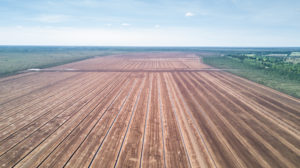Peat, the supreme substrate raw material
The main raw material in Kekkilä Professional substrates is first-rate White or Brown Sphagnum peat which is harvested from our own bogs. This article covers the main advantages of peat in substrates.
The basic ingredient in the Kekkilä Professional substrates is either White or Brown Sphagnum peat. The peat comes from our own bogs, and thanks to the Kekkilä Professional production methods, contains naturally occurring biologically active agents. Continue reading to learn about the advantages of peat in growing media.
Organic substrate made by nature
Peat consists of 95 % organic material. It is a mixture of decomposed plant material that has accumulated in a water-saturated environment without oxygen. Sphagnum moss is one of the most common plant species found in peat bogs. Peat, which is extracted from bogs dominated by this group of species, is often described as Sphagnum peat. Sphagnum peat, therefore, mainly contains decomposed Sphagnum moss.
The formation of peat is a continuous process. It typically accumulates in bogs at a rate of 1-2 mm per year.
Peat from the Nordics
The accumulation rate of peat is greatest in areas where the ambient temperature is high enough for plant growth. In addition, there also needs to be waterlogging. This is important because waterlogging limits aerobic microbial activity from breaking down the plant material.
A combination of these three conditions cause water logging:
- a specific amount of rainfall;
- a specific topography of the landscape;
- low transpiration rates.
Such conditions are found most frequently in the Northern hemisphere.

Peat – the best growing media for plants
As a substrate constituent peat is superior to any other material.
Physical advantages of peat
Sphagnum peat has a high water holding capacity (approx. 65% in volume). This helps to provide adequate water and water-soluble nutrients to the roots. It also has a high air-holding capacity (approx. 30% in volume). The air-holding capacity is important as the roots (and beneficial microbes in the root zone) need a constant supply of oxygen. Oxygen is required by the plant for respiration and supporting the essential functions of water and nutrient uptake. Thus, a perfect balance of both water and air is crucial in any substrate.
Peat has a high cation exchange capacity (CEC). The CEC refers to the ability to attract, retain and exchange cations such as potassium and calcium ions. A high CEC allows a reservoir of nutrients to be held within the substrate instead of being flushed out during irrigation. These retained nutrients slowly replenish those removed from the substrate by plant uptake.
Because of its ability to hold water and nutrients, peat saves fertilisers and water.
It has a low bulk density and is easily compressible. This makes it very fuel-efficient for transportation over long distances. This helps to keep transportation costs low and to reduce the impact on climate change.
Peat has high structural stability.
Biological advantages of peat
Our peat is produced in remote areas where there is no commercial crop production activity. As a result, it does not contain weeds or other contaminants. In addition, it means that it is naturally free of human and plant pathogens, parasitic nematodes, pests and fungi of cultivated plants. Finally, during winters, temperatures can drop below -25 ⁰C which helps to eliminate unwanted pathogens.
Peat contains beneficial microbes which help to prevent fungal diseases. Would you like to learn more about these beneficial microorganisms, read this article: Beneficial microorganisms in peat.
The naturally occurring humic acids within this raw material stimulate root growth. Since peat is a 100% organic material it also is compostable and does not produce unwanted waste.
Chemical advantages of peat
Natural peat, straight from the bog, has a low pH of around 3.5 to 4.5. Because of the consistently low pH, growing media manufacturers can adjust the pH of the peat substrate depending on the needs of the crop. Most commercial horticultural crops prefer a slightly acidic substrate. Manufacturers usually add calcium carbonate to adjust the pH of commercial growing media to be between 5.5 and 6.
Peat has a low electric conductivity (EC) which makes it easily adjustable. EC is an expression of the number of salts in a solution. Low EC illustrates that there are very little available nutrients or other salts which can even cause phytotoxic effects such as sodium or chloride ions. Have a look at this article to learn more about pH and EC-values in general. So, we could say peat is a ‘blank canvas’ as it comes to EC. This blank canvas allows the substrate producer to enrich the peat with specific starter fertilisers. The possibility to adjust the number of specific nutrients accurately is important to growers. It is important because the need for fertilising depends on the type of crops and stage of growth.

